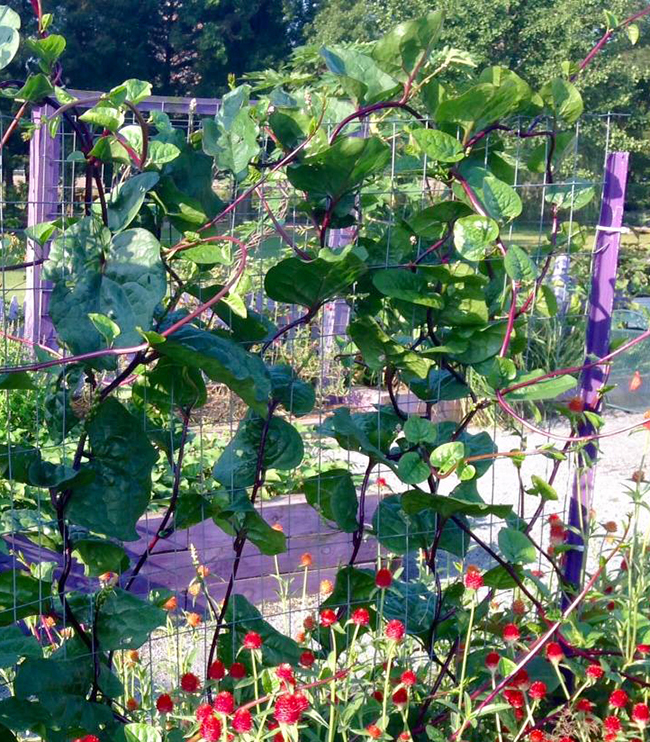This Red-Stemmed Vine Is Both Attractive and Edible

Red-stemmed Malabar spinach is a favorite among gardeners who desire attractive edibles. The climbing vine features attractive fushcia-colored stems along with tasty, edible foliage. Photo by H. Jones, courtesy UTIA.
My favorite edible plants are ones that taste good, have excellent nutritional value and look attractive for a long period of time. Basella rubra or red-stemmed Malabar spinach fits this description perfectly. As the tender lettuce leaves of springtime begin to turn tough and bitter, the adventurous culinary gardener can turn to this wonderful vine for a steady supply of tasty summer greens.
Valued for the brilliant fuchsia color of its leaf stems and veins as well as its mild flavor, B. rubra is an eye-catching addition to the garden. Both this species and its plainer, not-so-colorful cousin B. alba are native to Southeast Asia and therefore flourish in our hot humid Tennessee summers. These vigorous herbaceous vines can grow up to 35 feet in one season. Though technically a perennial, it is not cold-hardy and is grown as an annual in temperate climates.
Malabar spinach will grow well in a relatively wide pH range from 5.5 to 8 and will survive low-moisture and low-nutrient soils, but for the mildest flavor and most rapid growth, the vine should be plant in moist well-drained soil with high organic matter and typical vegetable garden nutrients. It grows best in full sun but will also tolerate light shade. Easily grown from seed or cutting, Malabar spinach is readily available in many commercial seed catalogs. Seeds may be started indoors 6 weeks to 8 weeks before the last frost and transplanted outside after the weather has settled and nighttime temperatures are consistently above 50° F.
While it is resistant to the vast majority of our common pests and diseases, Malabar spinach has shown susceptibility to soil nematodes. If the plant looks nutrient deficient and generally stunted even though it’s being given ample water and average garden soil, it could very well be suffering from nematode damage. If nematodes are identified, destroy the plant and do not add it to your compost pile. Harvesting young growing tips and leaves frequently will encourage the development of fresh, succulent, new growth and keep the plant size in check.
Though commonly called vine spinach, red vine spinach, climbing spinach, creeping spinach, buffalo spinach, Malabar spinach and Ceylon spinach, this plant is not truly spinach. Like spinach, the leaves can be eaten raw or cooked, but the leaf has a thicker texture and a less bitter flavor than spinach due to lower levels of oxalic acid. To some, it is an acquired taste, but to most people who enjoy spinach, kale, lettuce and Swiss chard, it is quite delicious. The young leaves and tender terminal stems are best for cooking. Add to soups and stir-fries in the final stages of preparation to avoid overcooking. Larger leaves and older stems will contain more of the high fiber mucilage, which is the same substance that gives okra its characteristic slime.
Later in the season, dark purple berries will appear in abundance. These can be used as a dye for whip cream or yogurt for a fun addition to a meal.
We regularly grow Malabar spinach in the Kitchen Garden at the UT Gardens, Knoxville, and the Gardens in Jackson will be planting it this spring as well. Visit either site anytime this spring or summer to check it out.
The UT Gardens includes plant collections located in Knoxville, Jackson and Crossville. Designated as the official botanical garden for the State of Tennessee, the collections are part of the UT Institute of Agriculture. The gardens’ mission is to foster appreciation, education and stewardship of plants through garden displays, educational programs and research trials. The gardens are open during all seasons and free to the public. For more information see the Gardens website: http://utgardens.tennessee.edu.










